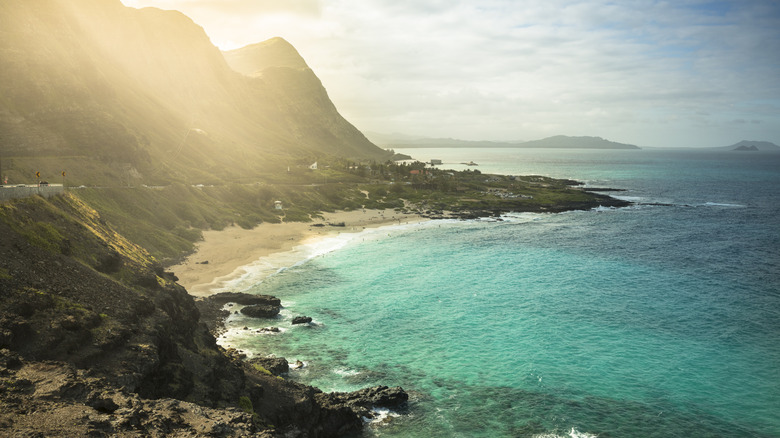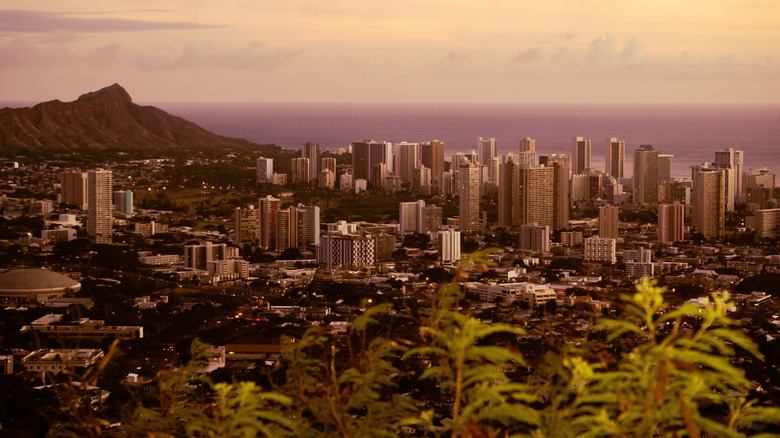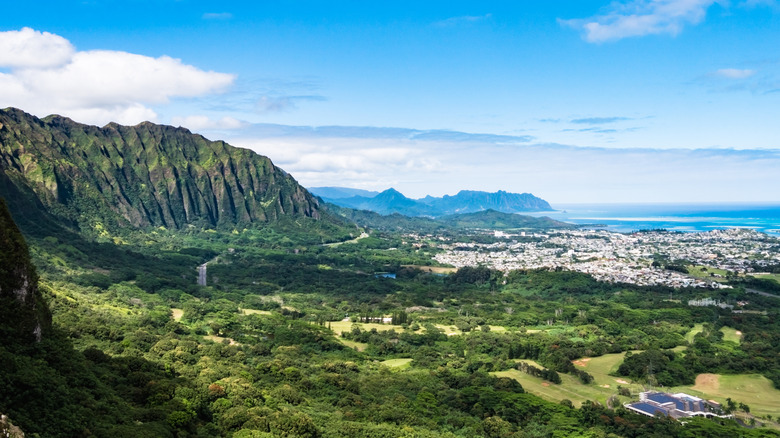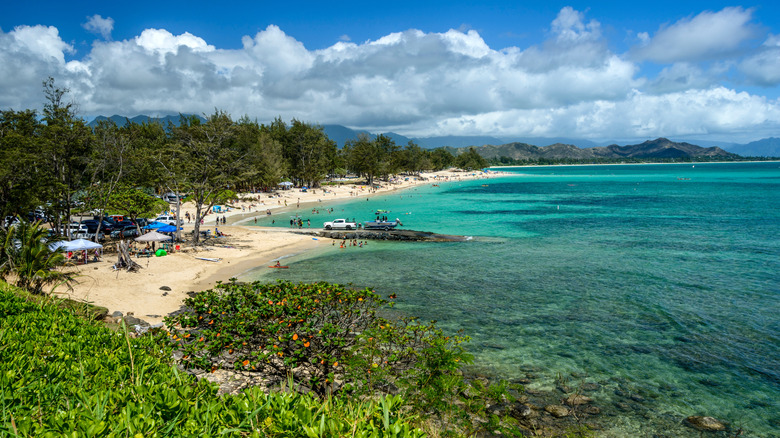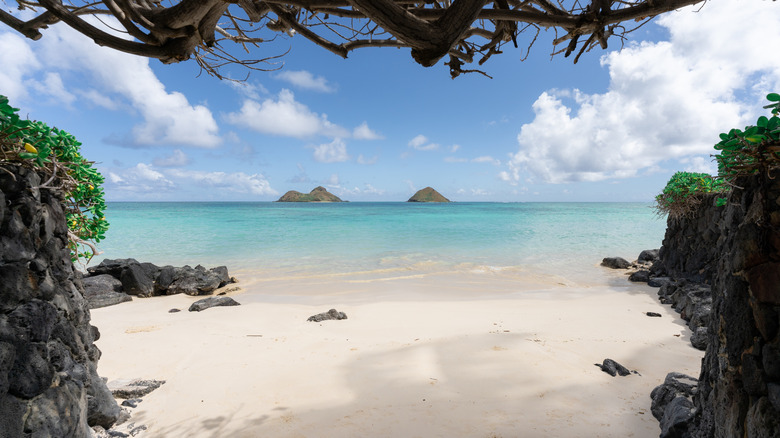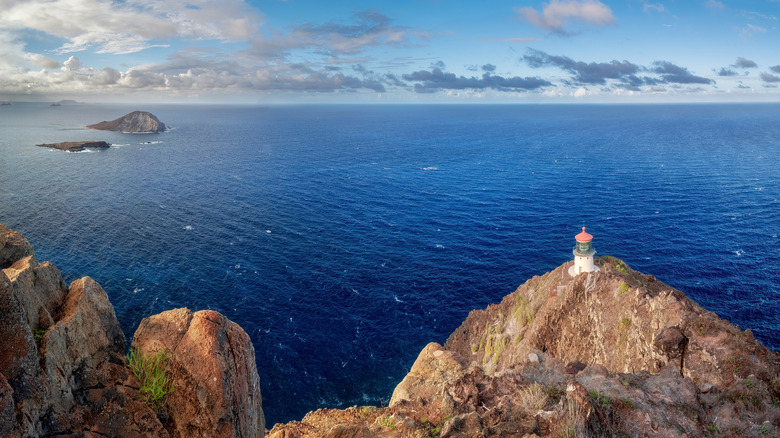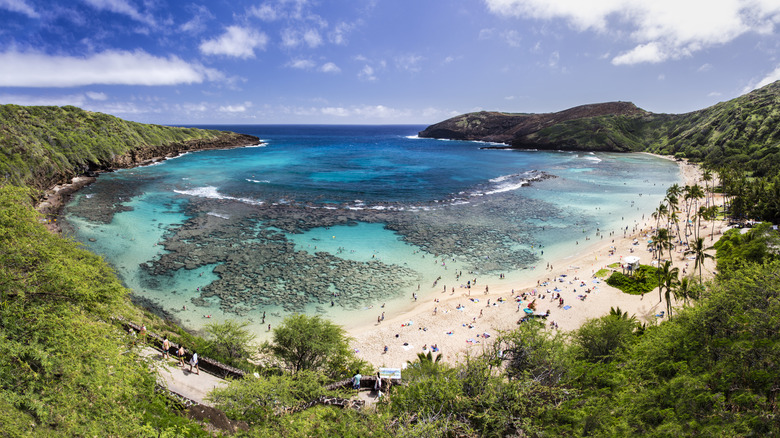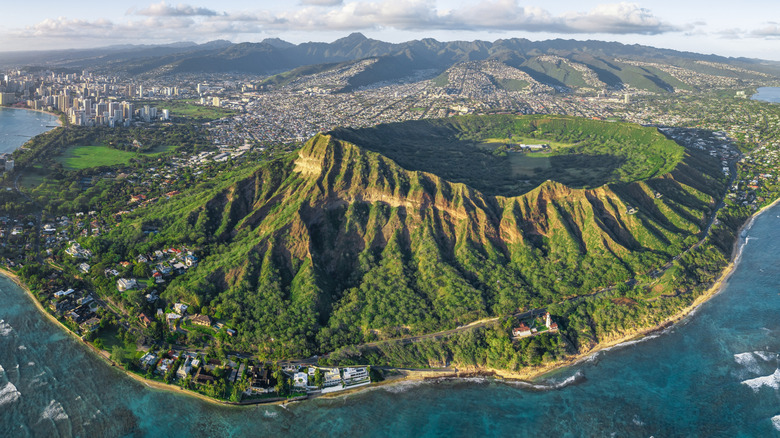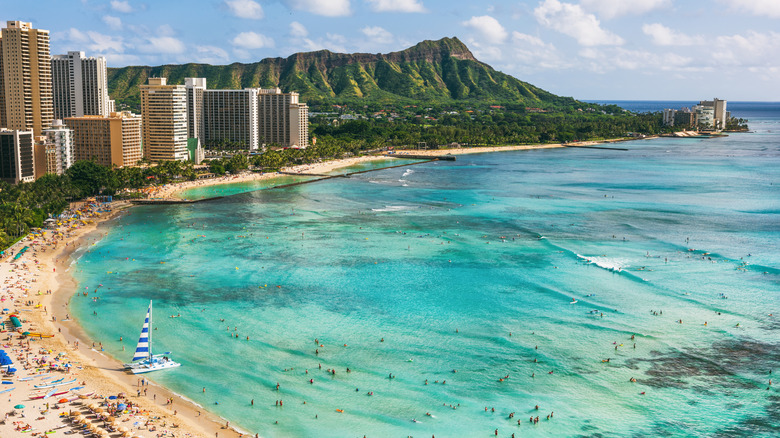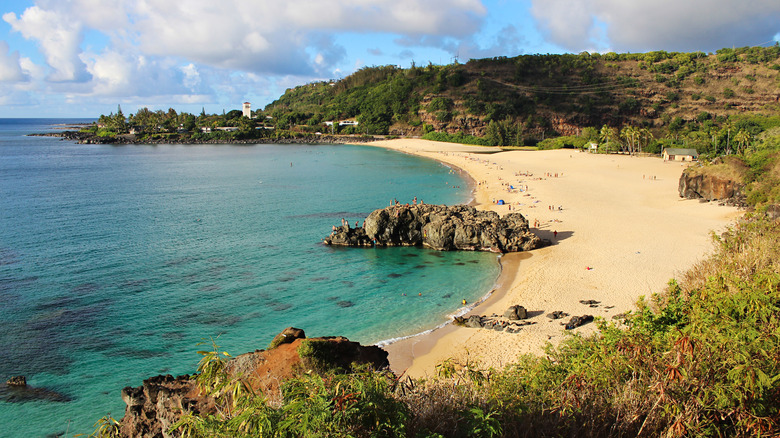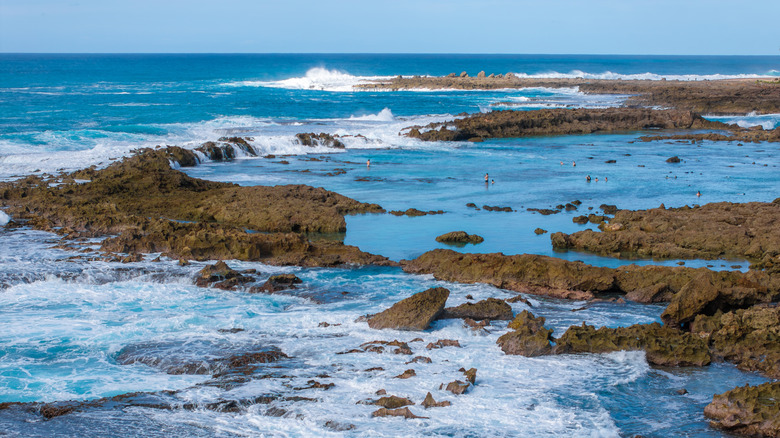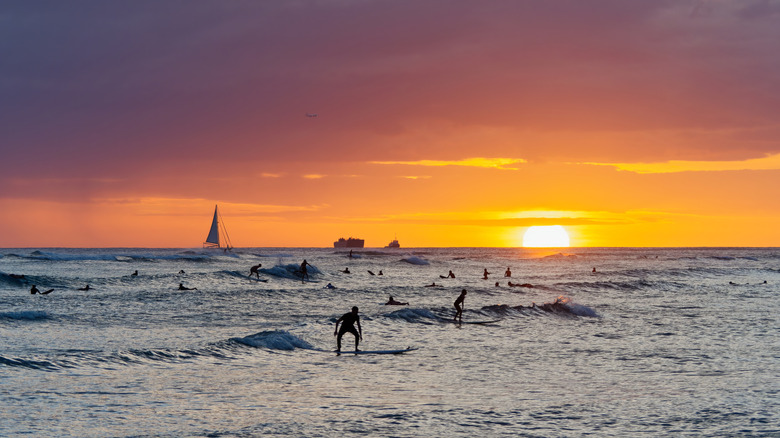Oahu's 10 Best Destinations For Breathtaking Views And Flawless Beaches, According To Reviews
The Hawaiian island of O'ahu epitomizes nature at its most dramatic. It simply has everything. From jagged volcanic ridges to crescent-shaped bays and waters thriving with marine life, the landscape here never ceases to put on a show. There are views around every corner that will take your breath away, and the iconic, world-renowned beaches are spectacular. You could be perched high up on a lookout with the wind pounding on your face or down at ground level digging your toes into fine, powdery white sand. Whatever you're doing on this remarkable island, you'll be doing it surrounded by sights that will live long in the memory.
We've taken to guides, blogs, and renowned publications, comparing their opinions with real reviews to compile a list that we hope will help you plan a trip to one of Hawaii's most beloved islands. We've blended iconic beaches with panoramic vistas and rugged coastal hikes to give nature lovers planning a trip here a clear idea of where to see the island at its best. Whether it's sunrise spots or famous surf breaks, these are the wonders that have put O'ahu at the top of many bucket lists.
Tantalus Lookout
Just on the edge of the capital, Honolulu, you'll find Pu'u 'Ualaka'a State Park. Within it is the scenic Tantalus Lookout viewpoint. This is where to go for sweeping views of the city, Waikiki Beach, and the iconic tuff cone of Diamond Head. On clear days, you can also spot Pearl Harbor off in the distance. The drive is all part of the fun day out. It's a road that's all hairpin turns and jungle views, reminiscent of the famous Road to Hāna experience on Maui. You'll be tempted to stop off at the plentiful scenic pull-offs on the way up, but it's at the top where you'll find one of O'ahu's prime sunset spots.
Sitting at 1,048 feet on a big, soft lawn that's just made for stretching out, you can take in the city and all the island's natural wonders. The imposing volcanic crater that dominates the skyline is broad and circular-shaped with steep, rugged walls and a wide, open crater floor. Huge rainbow arcs are often painted across the heavens, and as the sun sets, the city lights flick on below, and the sky turns into a symphony of molten colors while shadows spill across the valleys.
On Google, the reviews number in the thousands, and the vast majority rank it as a 5-star attraction. The highlight is undoubtedly the big orange ball dipping down below the horizon, with one reviewer enthusiastically remarking, "The lookout is especially magical at sunset, when the sky lights up in shades of orange and pink, casting a golden glow over the island. At night, the city lights twinkle below, creating a mesmerizing scene."
Nuʻuanu Pali Lookout
A short drive from Honolulu is Nuʻuanu Pali Lookout, a vantage point high up in the Koʻolau Range with views across O'ahu's windward side. The drive up leaves behind the urban landscape of the capital and passes through thick, green forest that gets you in the mood for the spectacle of nature that unfolds at the top. There, a stone viewing platform stands at around 1,200 feet above the shoreline, offering sweeping views of sheer cliffs, lush green valleys, and turquoise waters.
However, Nuʻuanu Pali Lookout isn't only about breathtaking views. This site is culturally important and considered sacred by many locals. One of the reasons is because this was the site of the 1795 Battle of Nuʻuanu, when Kamehameha I, King of Hawaiʻi, led his forces to take control of Oʻahu. In addition to this battle, locals believe the entire Pali area is haunted. Stories of ghostly warriors and torchlit "night marchers" add to the area's mysterious aura.
Around Nuʻuanu Pali Lookout, there are a couple more well-known trails. The Old Pali Road Trail starts near the lookout and follows part of the original highway built in the late 1800s. It's an easier, more accessible walk through the area's history. However, for those seeking a bigger challenge, the Pali Puka Trail branches off nearby. It's a short but steep climb to a natural hole in the cliffs with dramatic views of the Windward Coast.
Kailua Beach Park
When you want classic O'ahu seaside scenery without the Waikīkī crowds, give Kailua Beach a try. It's just a 20-minute drive from Honolulu, but you couldn't feel further away from the hustle and bustle. It's a long stretch of pristine white sand and clear blue water, with an atmosphere that feels more local than touristy. The bay curves gently for 2.5 miles, with the distant Koʻolau Mountains dramatically rising in the background. Windswept dunes give you an elevated view of the area and are a great spot to sit in the early mornings when things are quiet and calm and the trade winds haven't yet picked up.
In the water, the soft, sandy bottom underneath is ideal for wading while you await the sunrise, or you can just leisurely float around in the calm blue sea. And that sunrise is well worth the early alarm, too. It paints a canvas of color over the Mokulua Islands, those iconic little islets with their seabird sanctuary. You can hire a kayak and paddle out to them or take a guided tour for a more in-depth look and local insight. One regular reviewer on Tripadvisor poetically said, "The views were breathtaking and as pretty as a postcard ... The sky and the sea were a deep blue, and the sand was snow white."
Lanikai Beach
Just a mile away from Kailua Beach is Lanikai Beach, a name that translates to "Heavenly Ocean" — and you'll see exactly why the moment you arrive. The turquoise water is so clear that you could be floating in the air, and the white sand is so fine that it's like baby powder. On top of this, its laid-back, unspoiled character ensures that Lanikai Beach is consistently voted as one of the world's best. With no big hotels crowding the view, it's a quiet escape that the locals love every bit as much, if not more, than the visitors who turn up year after year.
It's not just sand and water that dial up the wow factor here. Just like at Kailua Beach, the Mokulua Islands offshore give you a postcard-perfect backdrop. They light up with saturated colors at dusk, and even though the sun sets behind them, they still deliver rich golden and purple skies. Hanging around after the crowds leave is a perfect way to spend the evening, with the clear, dark skies ideal for stargazing. Morning sunrises glow orange over peaceful waters, and this is the ideal time to take a short hike up the Pillbox Trail behind, which rewards with sweeping coastal views.
Lanikai Beach also has an offshore coral reef. It keeps the waters close to shore calm, and the shallow lagoons and tide pools are ideal for beginners. Even in waist-deep water, you'll spot coral heads and tropical fish. If you go further out, you'll find bigger coral gardens and sea turtles, while in winter, you might even hear the hypnotic singing of humpback whales.
Makapuʻu Point Lighthouse Trail
From Lanikai Beach, head down the highway in a southeasterly direction and turn left at Makapuʻu Lighthouse Road to access one of the most spectacular coastal hikes in Hawaii. It's a paved 2-mile round-trip that leads to a historic lighthouse and a stunning lookout over rugged cliffs and the dramatic ocean, laying Oʻahu and its shores out like a giant postcard. Koko Head, a volcanic ridge on the island's southeastern tip, and Koko Crater, the huge bowl-shaped caldera carved into it, are on one side. As you climb higher, the trail opens up to reveal the east coast and small offshore islets.
Thanks to those expansive views, it's considered one of the best sunrise hikes on Oʻahu. Early morning light hits the water in a radiant glow, and the temperature is cooler. At other times, the trail can be hot and exposed, so you'll want to bring a hat and plenty of water. The hike is understandably popular, with frequent benches and the easy paved trail making it an accessible hike for most people. At the top, there's the historic red-roofed 1909 lighthouse standing over the blue expanse.
This is the perfect spot for wildlife lovers, particularly between November and May. During these months, it becomes a prime whale-watching location. You often see humpbacks on their long migration, breaching the surface in slow, graceful arcs before crashing back into the ocean in an explosion of whitewater. Then, there are the nearby islets, which are actually sanctuaries sheltering nesting seabirds like the ʻiwa and other native species. Bring your binoculars for some amazing sights and endless photo opportunities.
Hanauma Bay
Formed inside a curved volcanic crater that wraps around a sheltered white sand beach, Hanauma Bay is one of Oʻahu's most striking coastal settings. Dramatic cliffs rise behind the sand and give it a unique, enclosed feel, while its calm, protected waters are a signature sight on the island. Its status as Oʻahu's only dedicated snorkeling beach is what has made it particularly famous. While O'ahu does have other world-class spots, Hanauma Bay is the only beach on the island that is fully managed and designed for snorkeling as its primary purpose.
It was declared a Marine Life Conservation District in 1967 to protect its natural beauty and biodiversity. Visitor numbers are managed, with entry fees set by the Division of Aquatic Resources and a mandatory viewing of an educational video. These regulations ensure that this breathtaking spot retains its unspoiled charm while letting people see Oʻahu's marine world without harming it. It's the ideal spot for families and beginners to experience dense coral formations, which you can find just offshore. The colorful underwater landscapes teem with tropical fish, including triggerfish, yellow tang, parrotfish, and butterflyfish. Even in shallow areas, snorkelers are treated to an abundance of diverse marine life. Explore a little further out, and you'll encounter bigger fish and Hawaiian green sea turtles gliding through the deep reef channels.
Diamond Head State Monument
To the east of Waikīkī Beach rises Diamond Head, arguably Hawaii's most photographed landmark. This almost perfectly circular crater, with its steep, jagged ridge, forms an unmistakable silhouette above the city. The interior drops down into a wide bowl of raw, exposed rock that was shaped by a single violent eruption around 500,000 years ago. The climb up is short, but it can be demanding. Switchbacks zig-zag up the crater wall and can be steep and uneven. You must also climb multiple staircases, including a tough 99-step section, and navigate through narrow tunnels, including a final passage that emerges just below the summit.
The elevation gain exceeds 500 feet in under a mile, which makes it a moderate challenge for which you'll need steady footing, patience, and plenty of water. One Tripadvisor reviewer put their thoughts on record when they said, "It's challenging, but not overly so." Climbing at first light will keep things cool, and the route will be less busy, which is ideal for those who want to catch that first glow spilling over the ocean. As you climb, the trail opens up, offering views of the rough volcanic coastline and the vast Pacific Ocean stretching east.
You'll also see distant landmarks like the volcanic ridge of Koko Head and the long Wai'anae Range on the western side of the island. At the summit, your strenuous efforts are rewarded with what one Tripadvisor user called "spectacular vistas with incredible photo ops." The 360-degree view sweeps over Waikīkī, Honolulu, and the crater's massive bowl. The climb is so popular that Diamond Head has a reservation system, but planning ahead is well worth the effort.
Waikīkī Beach
The southeast loop is completed with a visit to Waikīkī Beach, one of the world's most iconic stretches of sand. It's dominated by the dramatic volcanic backdrop of Diamond Head and is famous for sunsets that transform the sky into vivid bands of orange and pink. In fact, it won America's Best Sunset Spot Award for 2025. Those sunsets are complemented by calm ocean views and swaying palms, creating a picture-perfect scene. The beach itself is a 2-mile sweep of white sand and gently rolling waves that are perfect for beginner-friendly surfing.
However, Waikīkī Beach isn't just one continuous stretch — it's actually made up of smaller, interconnected sections, with each offering its own scenic vibe and experience. Fort DeRussy Beach has a quiet, calm vibe with clear ocean views. It's the ideal spot to unwind and take in the sunset away from the crowds. The Royal Hawaiian section is the classic spot for that wide sandy shoreline and the instantly recognizable Diamond Head backdrop. At Kūhiō Beach, you'll find a family-friendly appeal with calm, clear water and open views across the Pacific, while Queen Surf Beach, at the eastern end of Waikīkī, is mellow and less crowded, with scenic ocean views and surf breaks. With a good choice of restaurants and bars stretched out along the shoreline, Waikīkī Beach is easily a place to spend the entire day, from morning to well after dark.
Waimea Bay
The North Shore of O'ahu is legendary, and Waimea Bay is one of its most iconic spots. A 45-minute drive from Honolulu, the shore is wide and sandy, and the aquamarine water is perfectly clear. In summer, it practically calls you in. In winter, it turns wild. Its massive waves can reach up to 50 feet, and it's a place where only skilled surfers take on the challenge because everyone knows how dangerous these monsters are. The prestigious Eddie Aikau Big Wave Invitational takes place at this time, but if you are not participating, you can watch the spectacle from a safe distance.
Come summer, it's a different beach. The ocean calms down, the tide turns lazy, and the horizon sits flat. This shift from raw power to tranquil bliss is surreal, and it's a great place to sprawl out on the golden sands, soak up some rays, and relax. It's perfect for swimming or grabbing a board for some easy stand-up paddleboarding, while snorkelers can check out its healthy reef and marine life. One Google reviewer described the bay as having "soft sand and calm waters during the summertime for swimming [and] snorkeling," while going on to mention that they "had a sea turtle swim within inches."
Whatever you do on the beach, make sure you don't rush off too early. Regardless of the season, the sunsets here are well worth hanging around for. Everything gets washed in color once most folks have gone home. It's the perfect spot to absorb those last rays and reflect on nature's beauty. However, the bay is not the only treasure this area has to offer. Just behind you is the start of Waimea Valley, with its winding rivers, spectacular waterfalls, and lush green foliage.
Shark's Cove
Just a short 10-minute walk from Waimea Bay is Shark's Cove, which isn't a traditional sandy beach for those looking to relax and absorb some rays. It's a rocky coastal inlet with clear blue water, beneath which are giant coral heads and boulders that create shadowy swim-throughs and hideaways. The reef is alive with thick schools of fish and tunnels and ledges that entice exploration. It's essentially a live-action aquarium and is known as one of the world's best shore dive sites.
More than 40 marine species crowd these clear shallows and deep pockets. There are colorful fish darting through the equally colorful coral, sea turtles drifting around without a care in the world, and even the odd reef shark harmlessly cruising by. It's busy down there, to say the least, but you'll want to admire the action for as long as your oxygen tank permits. The point where the cove meets the ocean is around 20 feet deep. After which, the bottom slopes down to 45 feet and gives way to even better diving territory with even better visibility.
For those without scuba certification, you can just grab a mask and snorkel and float around on the surface to enjoy the breathtaking views below. One impressed Google reviewer said the cove is "a must-go place to snorkel on O'ahu in the summer" before going on to explain that "the water was as clear and calm with as much sea life as almost anywhere else." Whether you snorkel or dive, you'll be doing it in the summertime when the swells are low and the water is calm. During the surf season (October to April), the waves pick up, making the conditions unsafe.
Methodology
To get an idea of the most revered places on O'ahu for views and beaches, we took to local-focused travel guides and blogs, such as Hawaii Activities and The Hawaii Vacation Guide. We also looked at commercial travel lists with well-reviewed attractions on sites like Expedia, Viator, and Tripadvisor. Travel blogs, such as Bon Traveler and Pure Wander, were also taken into account, along with more widely recognized guides like Lonely Planet.
We then created a list of the most frequently and positively mentioned places and compared them to Tripadvisor and Google Reviews to see what actual travelers were saying. We removed attractions with limited numbers of reviews and low scores between the websites to come up with a solid top 10. We didn't rank them in any particular order, choosing instead to lay them out by geographic location. We mapped out a southeast loop starting and finishing in Honolulu, followed by the sights along the north shore.
